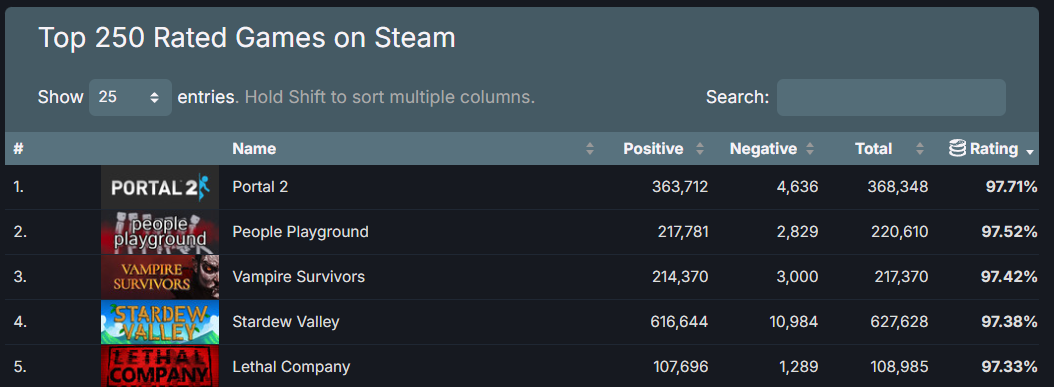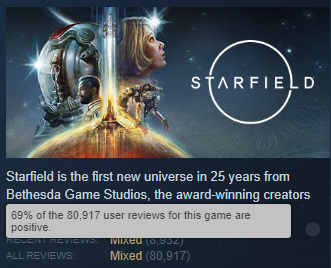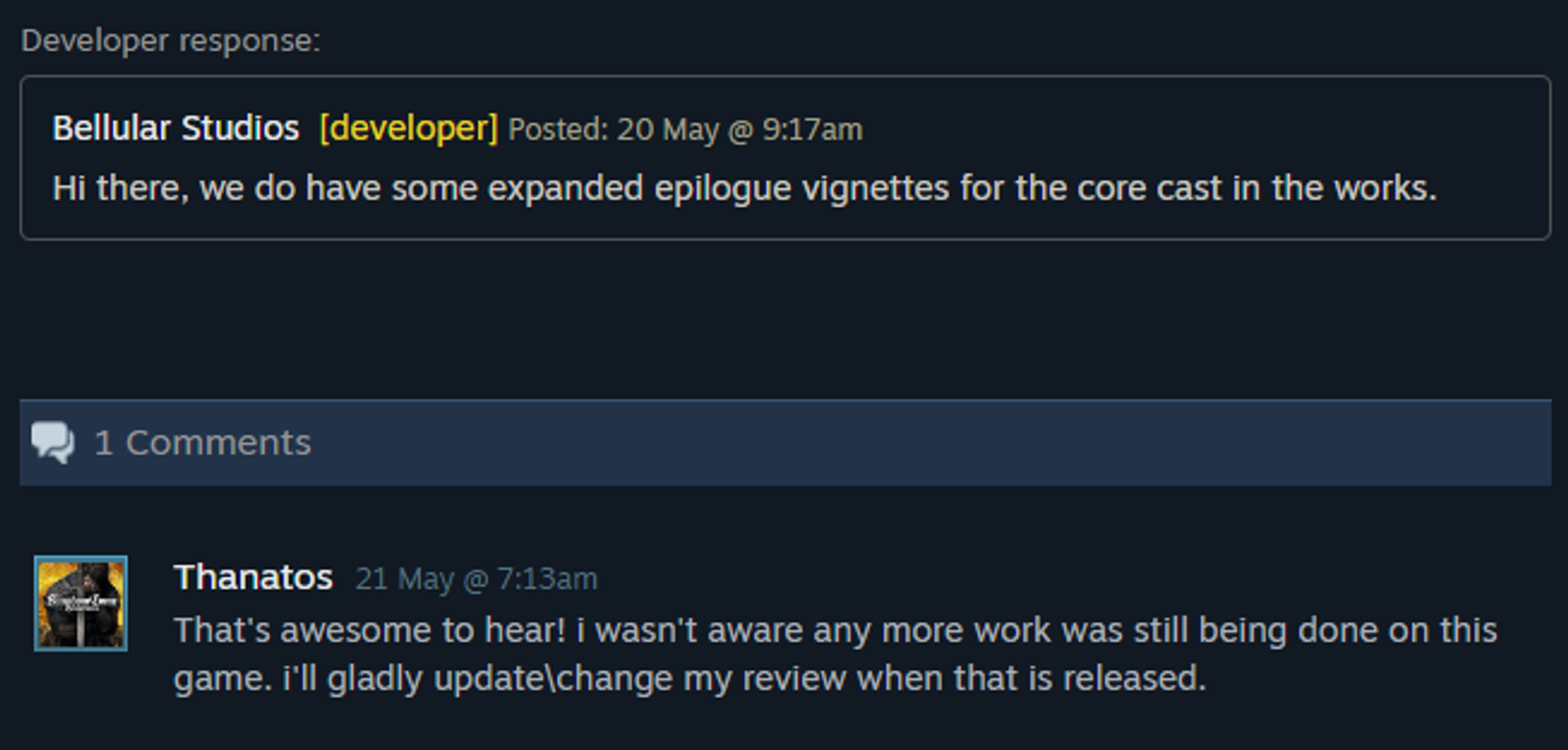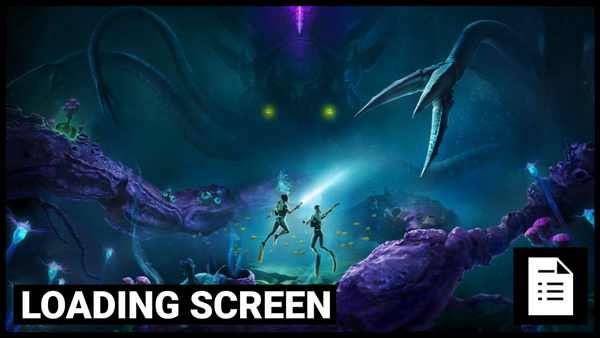The Starfield Steam Review Situation
Bethesda is taking flack for responding to Starfield Steam Reviews, but it turns out everyone does it! They just do it better than Bethesda.

- When is the last time that you changed your mind about a game?
- Especially one you disliked, and especially one that you felt negatively enough about to leave a Steam Review.
- Once you’ve made your mind up, often no amount of changes or playing the game will get you to go back and update that negative review to a positive one.
- Except it turns out that’s not the case across the whole gaming audience, and some companies will go to extreme lengths to be able to try and convince you to change your mind.
- A viral twitter post from Fallout Youtuber JuiceHead spotted that the Bethesda Developer accounts on Steam have been responding to Negative Steam reviews for Starfield - attempting to change people’s minds about the negative aspects described in the review.
Bethesda is responding to negative Starfield reviews on Steam. Absolutely bizarre if you ask me and despite media attention this hasn't stopped, the last response is from today pic.twitter.com/ay589tg8cc
— JuiceHead (@JuiceHead33) November 28, 2023
- Except the thing is, despite the original poster’s confusion at the fact that this hasn’t been stopped despite media attention - this is an industry standard trend.
- One Bethesda themselves have been doing for years.
- It started with Indies and has spread to AAA devs - because the Steam Review Score is something that’s so important to developers and publishers that there are material benefits to individually trying to fix negative reviews.
The Bethesda Backfire
- Every game gets negative reviews.
- It’s guaranteed.
- It’s common wisdom that folks will much sooner take the time to tell you they’re unhappy than that they enjoyed something.
- Even looking at all time numbers - no game has ever achieved a 100% User Score rating on Steam

- But the 32% difference between Portal 2 and Starfield on Steam reflects itself as an off yellow Mixed Rating for the latter.

- And while the purpose of Steam’s algorithm is that a Mixed rating simply means that it will mainly be recommended to folks who have an interest in this specific genre - Starfield never needed that to have folks engage.
- Which is part of the problem really.
- A lot of folks came to Starfield and found a game that didn’t meet their expectations from Skyrim, from Fallout or even just from the length of time between the announcement of Starfield and the release.
- The actual reasons aren’t what we’re here for.
- Instead we want to look at the reviews left - and how Bethesda responded.
- When a game is receiving negative reviews, they tend to come down to three types:
- Funny Memes - People have a platform and they want to use it to dunk
- Emotional Disconnect - Players expected or wanted one type of experience and they’re getting something else.
- Technical Issues - The game is having problems on a performance, systemic or mechanical level
- The first one can’t have much done about it.
- The second one requires massive changes to alter people’s opinions- but the third one the developers can maybe do something about.
- A lot of folks will quickly leave a review when frustrated.
- Especially if that's faster than searching for a fix to the problem.
- And then that review will likely never get changed - even if eventually the user comes back and gets past their problem.
- So someone in management at Bethesda HQ has clearly had an idea.
- It wasn’t in response to Starfield’s Steam Rating being mixed - this practice has been in place since the days of Fallout 76 at least.
- It wouldn't help everyone, but it might help someone change their mind and be able to enjoy the game, getting them past whatever technical/gameplay hitch has them held up.
- Then a negative review becomes a positive one which is good for the devs- but also players have a better experience.
- That’s the Theoretical.
- The Practical is that at the scale you’re operating at as Bethesda, unless you’re willing to invest an exorbitant amount of money and time - you can’t do that in a bespoke manner.
- There are 80,000 reviews for Starfield, and 31% (24k) are negative.
- Which means that Bethesda had to build a procedure to handle this - and that meant a script for customer support staff - and that means copy pasting to generically respond to issues rather than specifically.
- Which is how we get to viral tweets where Bethesda appears to be telling users that the game “isn’t boring” when you can stand on an empty planet because it evokes a sense of scale and wonder.
- There's a kernel of a good idea in here.
- Sometimes offering a fresh perspective on a game can help people enjoy it in a new way, and that could change a negative review to a positive one.
- But the problem is that these negative reviews being responded to by Bethesda are from people who have emotional problems with Starfield as it stands.
- These are people who don't like Starfield because it's Starfield.
- Telling them how the intent behind planets devoid of interactive features is the creation of a feeling of scale and vastness doesn't work because the frustrated players don't actually care about that - they just don't like that the planet is empty.
- Explaining how complex the systems are for procedural generation means nothing when the player only cares that they see a loading screen.
- At the scale these reviews are at - suggestions to change their perspective or change up their playstyle will be immediately interpreted as scolding them for playing or thinking about the game "wrong".
- Especially when it appears that topics are being copy-pasted rather than individually written for each bespoke comment - the perception goes from "Developer responding to Criticism" to "Developer doesn't care enough to try".
- There's really no winning move here - because either these players can somehow be convinced to change their feelings about core concepts and limitations within Starfield, or Bethesda change the core concepts and limitations of their game.
- This model for community interaction works when you’re explaining to people how to get through the opening hours of Fallout 76, updating them on changes made as a result of patches or advising workarounds for common technical issues.
- It doesn’t work on feelings, not at this scale.
They Learned It From Watching You
- But the thing is - we know that Devs consider Steam Review Scores important - and we know that at the Indie end of the scale, this active monitoring of Steam Reviews happens all the time and has material impact.
- When the problem is scaled down to their level, it's much more important and meaningful to respond to individual reviews and try and respond to what people don't like.
- If you're getting 100 reviews total, One Bad Review is a big deal and worth the effort of a response, especially because sometimes that might lead to actual changes in the game to appease that person.
- This is why the response from Indie Devs to Starfield’s Review situation going viral was broadly - “Oh I wouldn’t have done it like that”.
- This is from Dillon Rogers, creator of Early Access title Immersive Sim Gloomwood - a hyper niche game that people adore - but that’s frequently flickering across the boundaries of Steam User Score ratings.
- For them, one review can be the difference.
- Gloomwood has 0.05% of the reviews that Starfield does.
For Gloomwood in particular, flipping reviews is kinda important, because we're right at the edge of 'Overwhelmingly Positive' (>95%), so one negative always pushes it out of what is the best selling bracket.
— Dillon Rogers (@TafferKing451) November 28, 2023
And often it's just someone like "I hit a bug" that we can fix. pic.twitter.com/pbooslvTvX
- While El Paso Elsewhere developer Strange Scaffold’s Xalavier Nelson talks about it in a holistic sense of User Reviews being one of the first things an audience sees.
- Nelson clarified elsewhere that Strange Scaffold do not respond to negative reviews themselves
So is it weird? Absolutely. will it continue to be used—and be used MORE—as Steam ratings play a role as the visible marker of a video game’s reputation?
— Xalavier Nelson Jr. 🔜 Game Awards (@WritNelson) November 28, 2023
Absolutely.
- There can be negative reviews sure, but if the negative reviews all have fixes listed or comments from the developers - it’s a different experience for the prospective player than a wall of red reviews at the bottom of the Steam page.
- A lot of this is about perception.
- Which means the actual answer is broadly this from New Blood’s Dave Oshry - that when Indie Devs do it, they are actually able to tailor their response to an individual - and can even appropriately address their audience in tone.
There is no issue with replying to negative reviews!
— The Dave Awards (@DaveOshry) November 28, 2023
The issue is when the replies come off as tone deaf and corporate copy pasta. https://t.co/FQUrXUEOI7
The proper way to respond to Steam reviews is just go through all of them and reply randomly with thoughts off the top of your head and hope for the best. pic.twitter.com/prxtpNNzfr
— The Dave Awards (@DaveOshry) November 29, 2023
- But the unspoken part of all of this is that the conversion rate for changing negative reviews to positive isn’t guaranteed.
- It doesn’t matter if you rebuild every aspect of your game to meet specific complaints from individuals.
- They simply might never actually change their mind.
- And we know that because this is something that happened with The Pale Beyond.
- Here’s a developer response to a May review of the game.
- The user wanted to have more of an ending to their game - their expectation was for explicit epilogues for the characters.

- In July - that user got exactly what they wanted, with the first content update including those epilogues.
- The Review hasn’t changed as of November 2023.

- That’s not the user’s fault - it’s the system of Steam working as intended.
- Users leave reviews at the time they play the game.
- And as above - conventional wisdom is that if you are frustrated or disappointed, you’re much more likely to leave a negative review.
- But like all the indie developers above - and even Bethesda - these Steam Reviews are effectively written in stone at the time they’re filed.
- Constantly sitting on the platform that controls the majority of the PC gaming market, telling users that your game is Not Recommended.
- So maybe that’s the takeaway from this video, that audiences supporting developers whose work they enjoy is vital, so leaving reviews is a great way to do that.
- But also that when you do leave a negative review - maybe see if the developer actually wants to do something about it.
- Because odds are they want to enjoy the experience.





